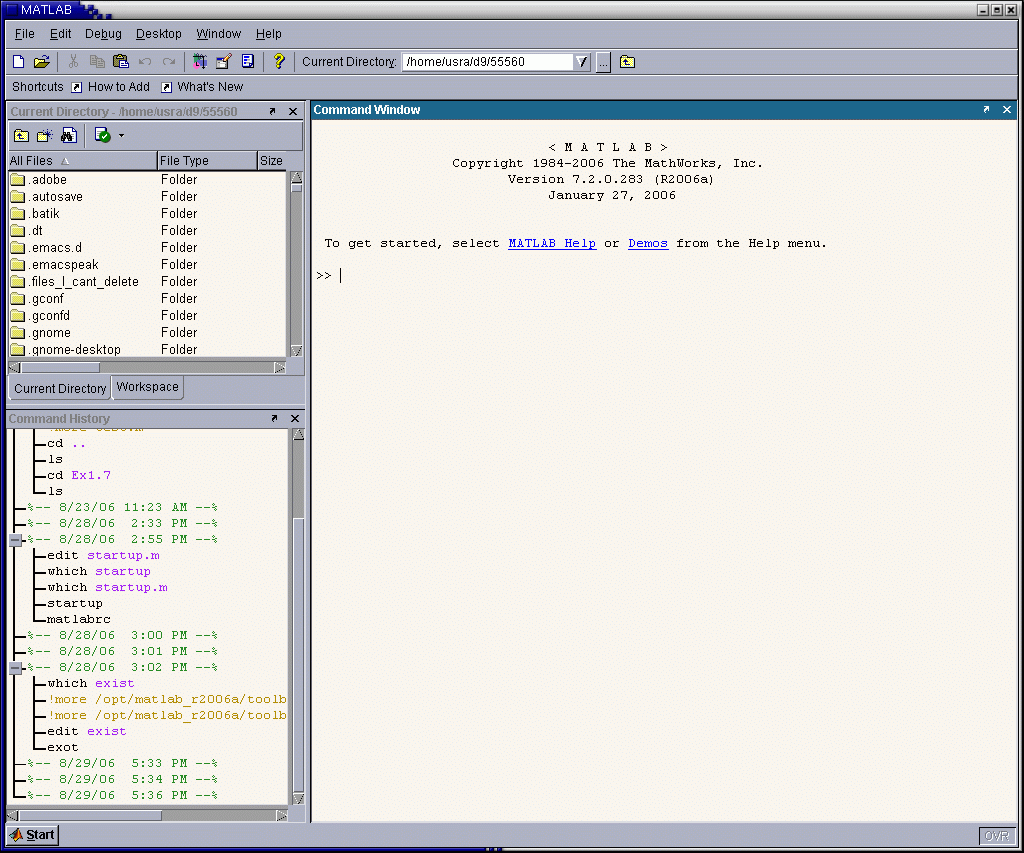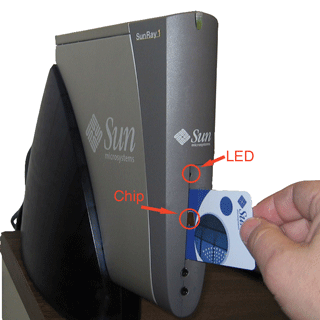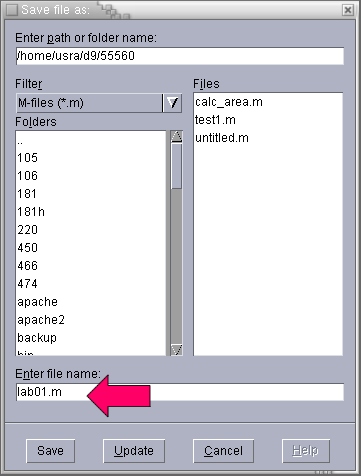First, find a Sun Ray
To use MATLAB on Strauss, the easiest path is to find a Sun Ray machine on campus.
Start on the Sun Rays, get used to MATLAB. Later, we'll show you how to use MATLAB from a PC or Mac.
Where can I find a Sun Ray?
Two main places:
- Willard Hall 009B
- (just inside the door to Willard Hall that faces Main Street, to the left as you enter, at the bottom of the ramp)
- The Basement of Smith
How will I know if I found a Sun Ray?
If you find one, the main screen should look something like this:

- You might also find a screen like the one below. This screen means someone is working on this machine, and locked it momentarily, perhaps to pick up a printout, or use the restroom. He/she should be back within 10-15 minutes. If she/he is NOT back within 10-15 minutes, then he/she is being quite rude---in this case, if there is no other machine available, you might consider resetting the machine. This, of course, could also be seen as rude, so think twice, and take a deep breath before you do it. It might be best to check with a consultant, instructor, or TA first if one is available---they might be willing to take the heat for you in case the culprit returns.
- The way to reset a locked session it to type "CTRL-ALT-BACKSPACE" twice. Note: this may cause the person to lose his/her work if she/he didn't save it, so be prepared for an unhappy camper. It is also possible the person just forgot to logout.
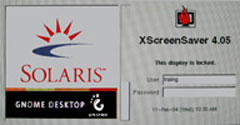
Ok, I found a Sun Ray. What next?
Next, you need to login. There is already a web page that describes how to do this in detail, which can be found at:
http://www.udel.edu/topics/os/unix/sunray/aboutTerminal.html
The following instructions are summarized from that page.
Using Sun Rays Terminals to Connect to Computers

As a Sun Ray user, you start a Sun Ray session by logging on to a Sun Ray server (e.g. schubert, vivaldi, haydn).
From the Sun Ray desktop, you can
- run software such as MATLAB on remote hosts such as strauss, as well as
- local software applications such as Firefox that you run on the local host (the Sun Ray server itself).
Your home directory (which contains all the files you save to the hard drive) is shared between strauss and the Sun Ray servers.
The Sun Ray server's software allows you to
- suspend your activity on the terminal at which you're sitting;
- free the Sun Ray for others to use; and later
- continue where you left off at any Sun Ray terminal.
This is possible because all of your session information is maintained on the Sun Ray server.
There is a load-balanced cluster of five Sun Ray servers, named Haydn, Schubert, Vivaldi, Verdi, and Debussy, not just one server. Each time you log on at a Sun Ray terminal, you might get a different Sun Ray server. The servers all act identically and share the information they need to identify you and your suspended Sun Ray session.
Sun Ray Smart Cards
A Sun Ray smart card is a credit-card-sized identification card used for logging in at a Sun Ray terminal.
You don't need to use a smart card to log in, but the card offers two key advantages:
- The login process is much faster; and
- you can suspend and restart your session at different Sun Rays.
Sun Ray smart cards are sold at the University Bookstore for around $6 to $7.
If you use a card, insert it before you start to log in
Insert it into the Sun Ray's card reader, as shown in the picture above. When the card is correctly inserted, the green LED light just above the card slot will illuminate.
Write your e-mail address on your card so you can be contacted by someone who may find your card. Private information, such as your password, is not stored on the card's smart chip. (You will always need your card and your password to continue the suspended session associated with the card.) The first time you insert your card, your identifying information and the internal identification code of the smart card's chip will be stored in a central database.
Starting a Sun Ray Terminal Session
- Find a Sun Ray terminal with
the standard login panel displayed
on the screen.
- Here is a standard login
with the "Welcome to haydn" message.
The welcome message will refer to one of the Sun Ray servers (haydn, schubert, vivaldi, verdi or debussy).
- You might see an
unoccupied Sun Ray terminal
without a standard login panel. It could have a
password-protected screen-saver such as the panel below.
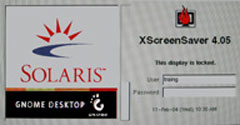
This occurs when the terminal's previous user leaves the Sun Ray in a locked state, expecting to return to it shortly. If the user doesn't return within a reasonable time, you may follow the reset instructions below to allow you to use the Sun Ray terminal.
Reset Instructions- If a smart card is in the Sun Ray, remove the card and give it to the site assistant. If the previous user retrieves his smart card, he will be able to use it to restart his session later on any Sun Ray.
- If a smart card is not there, depress and hold the "Control" and "Alt" keys, and press the Back Space key twice in quick succession. The terminal should become reset within 15 seconds.
- Here is a standard login
with the "Welcome to haydn" message.
- If you have a Smart Card, insert it before you log in. You must do this if you plan to suspend and resume this session.
- After the screen resets itself, you should see a standard login screen as above.
- If you see a locked screen
panel with your user name, then you
can resume
this suspended session by typing your user name and pressing
Return- Note: Instead of
Return, the key might be labeled as theEnterkey.
- Note: Instead of
- If you see some other user name in the locked-screen panel, then you are using the wrong card. You can not resume the session attached to this card. Pull the incorrect card out and then insert your card.
- Type your user name in the
box provided on the standard login
panel, and then press
Returnor click the button labeledOK.- Your username is your just the username part of your UD email address, i.e. just
jsmith, notjsmith@udel.edu - You will get a Welcome
message with your user name. If
you
see the "GNOME 2.0 Desktop" phrase under the your
welcome
banner in the login panel, type your password and press
Return.
Note: Your password will not appear as you type, and there are no little stars *** to guide you. Just type, and hope everything is working. :-)
- If you do not see the "GNOME 2.0 Desktop" phrase
- Select
Options > Session > GNOME 2.0from the pull-down menu. - Then, type your
password and press
Return.
- Select
- Your username is your just the username part of your UD email address, i.e. just
- Once logged in, you will be working in the GNOME Desktop Environment.
Ending a Sun Ray Terminal Session
You can suspend or you can terminate your session and its associated current jobs.
- Suspending a session
allows you to go to any Sun Ray later, and continue right where you
left off. (Applications that are running on a remote server, such as
Strauss, will continue to run even when your Sun Ray session is
suspended.)
To suspend a session, you must be using a Sun Ray smart card.
- Terminating a session will close all the open windows and stop all processing.
- If You Are Using a Smart Card
-
- To suspend a session, remove the card from the smart card reader. Do not select the Logout menu item.
- To terminate a
session, select the
Applications > Logoutmenu item. Do not select the "Save Current Setup" choice in the logout dialog box. Remove your smart card after the logout process is done.
- If You Are Not Using a Smart Card
-
- To terminate a
session, select the
Applications > Logoutmenu item. Do not select the "Save Current Setup" choice in the logout dialog box.
- To terminate a
session, select the
Resuming a Sun Ray Terminal Session
To resume a session, you should use the same card you pulled to suspend the session.
Insert this
card in any
Sun Ray terminal on the UD campus that is displaying the standard login panel. After a screen
reset you
should see the lock-screen panel
with your user name displayed in the
box labeled User:
You must type your password and
press Return
to resume your suspended session and continue your work.
Need more help?
Please consult the Troubleshooting section of GNOME Desktop for UD Sun Ray Terminals at the following link:
http://www.udel.edu/topics/os/unix/sunray/aboutGnome.html#troubleshooting
Ok, I'm logged in. What next?
Ok, you should now see the Gnome Desktop, which looks something like the image below (I'm showing only the upper left hand corner to save space):
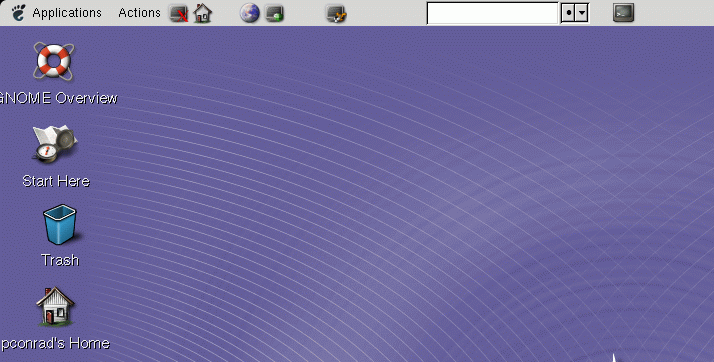
Step 2: Start up both MATLAB and a web browser (Firefox)
So, from Step 1, you should be logged into a Sun Ray, and looking at the Gnome Desktop.
Next, use the mouse to select the Applications Menu, and then the option Other, and finally MATLAB, as shown here:
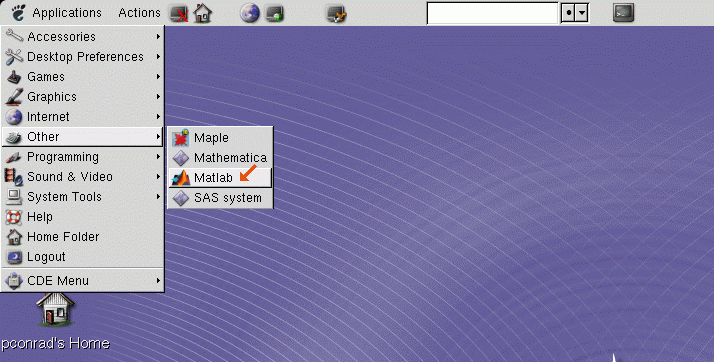
Next, you'll see the MATLAB splash screen (pictured below.) This should stay on the screen for a few seconds, and then be replaced by the MATLAB desktop, pictured after the splash screen.
MATLAB splash screen
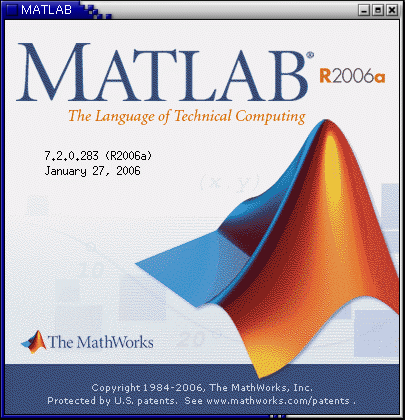
MATLAB desktop
